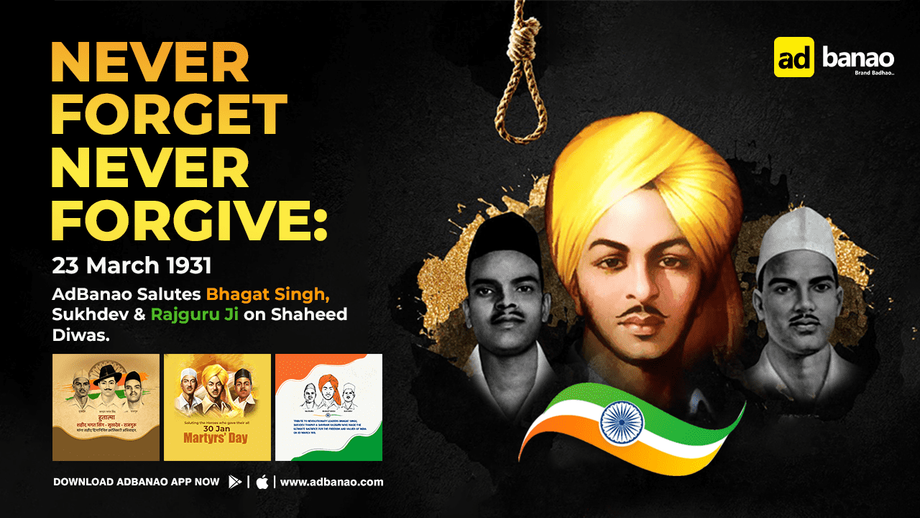Show your respect to India’s freedom fighters on this special day with AdBanao App. Read the special blog about Shaheed Bhagat Singh, Sukhdev, and Rajguru Ji.
Shaheed Diwas: Remembering the Martyrs of India’s Freedom Struggle
On 23rd March every year, India observes Shaheed Diwas, or Martyrs’ Day to pay homage to the three young revolutionaries who sacrificed their lives for the cause of India’s independence.
Bhagat Singh, Sukhdev Thapar, and Shivaram Rajguru were hanged to death by the British government on this day in 1931, after being convicted for the assassination of a British police officer in Lahore.
Their courage, patriotism, and sacrifice inspired millions of Indians to join the freedom movement and fight against the oppressive colonial rule.
Brief Story of Bhagat Singh, Sukhdev, and Rajguru.
Bhagat Singh was born on 28th September 1907 in a Sikh family in Punjab. He was influenced by his family’s involvement in the Gadar movement and the revolutionary activities of Kartar Singh Sarabha and Rash Behari Bose.
He joined the Naujawan Bharat Sabha, a youth organization founded by Lala Lajpat Rai, and later became a member of the Hindustan Socialist Republican Association (HSRA), a radical group that aimed to overthrow British rule through armed struggle.
Sukhdev Thapar was born on 15th May 1907 in Ludhiana, Punjab. He was also a student of the National College in Lahore, where he met Bhagat Singh and Yashpal.
He was an active member of the Naujawan Bharat Sabha and the HSRA and was involved in various revolutionary activities such as distributing pamphlets, organizing meetings, and collecting funds.
Shivaram Rajguru was born on 24th August 1908 in Khed, Maharashtra. He was a devout Hindu and a follower of the Arya Samaj.
He was also a skilled marksman and joined the HSRA to participate in the armed struggle against the British. He was a close associate of Bhagat Singh and Sukhdev and took part in several revolutionary actions with them.

The trio became famous for their daring attack on the British police officer John Saunders on 17th December 1928, in retaliation for the death of Lala Lajpat Rai, who was injured in a lathi charge ordered by another officer, James Scott. Bhagat Singh and Rajguru shot Saunders dead, while Sukhdev and Chandra Shekhar Azad provided cover. They then escaped from the scene and went into hiding.
On 8th April 1929, Bhagat Singh and another HSRA member, Batukeshwar Dutt, threw two bombs and leaflets inside the Central Legislative Assembly in Delhi, to protest against the repressive laws enacted by the British. They did not intend to harm anyone, but to make the deaf hear. They surrendered after the bombing and were arrested along with other HSRA members.
The trial of the Lahore Conspiracy Case, as it came to be known, lasted for two years. During this period, Bhagat Singh, Sukhdev, and Rajguru, along with other prisoners, went on a hunger strike to demand better treatment and equal rights for Indian political prisoners. They also used the court as a platform to propagate their revolutionary ideology and expose the injustice of British rule.
Despite widespread public support and appeals for mercy, the British government decided to execute the three revolutionaries. They were hanged in Lahore Jail on 23rd March 1931, at 7:30 pm, hours ahead of the official time. Their bodies were secretly cremated on the banks of the Ravi River by the jail authorities.

Download special Shaheed Diwas Posters, videos, trending reels, free statuses, audio jingles, WhatsApp stickers, and much more.

